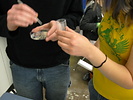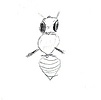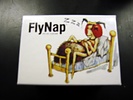Introduction
Students in Molly Renner's biology classes at City High School in Tucson, AZ created treehouses to document their fruit fly genetics experiments. Students conducted lab experiments to test for a variety of different mutations. The objective was for students to learn about the inheritance patterns of organisms by observing fruit flies, Drosophila melanogaster.
The teacher resource Fruit Fly Genetics Project explains how to undertake this project and provides downloadable materials for use in the classroom.
Portfolio Pages
- Fruit Fly Genetics
-
 © 2006 fruitflyyellow2
© 2006 fruitflyyellow2
- In my science class, we did a very interesting project on fruit flies. The reason why we picked fruit flies to work with is because they are the easiest species to use fly nap on. Our ideas and understandings were based on Mendel's experiments and principles on Genetics. Therefore the main idea is pretty much how characteristics are transmitted from parents to offspring. During the lab we kept track of mutations, vestigal wings and the wild type. During class we gathered up in partners to nap the flies in a certain order. First we separated the females and the males, then we separated the ones with vestigal wings and separate those as females and males as well. Basically this project was about learning how scientists predict the genetics of fruit flies and other animals. The key for this data was Genotype and Phenotype. The genetic make-up of the fruit fly is the genotype and its appearance is the phenotype.
- Fruit Fly Investigation
-
 © 2006
© 2006
- The purpose of our fruit fly experiment was to learn about genetics which is the study of DNA, genes and traits. We also studied mutations, which are the changing of an organism's genes and DNA sequence which makes the organism different than that of its species, and the effects of it on our flies. The reason we used fruit flies is because they are easily cultured and only live for about two weeks. They take up only a small space and females lay about 500 eggs in 10 days. This gives lots of data and multiple generations in a short period of time. Also, the mutations are quickly evident because of easy to see phenotypes.
- the ultimate show down of flies!
-
 © 2006
© 2006
- Our class is doing a lab which focuses on the genetic mutations in fruit flies. We are using fruit flies because they are easy to breed and it is easier to tell which genetic mutation that they have. Our group is focusing on the mutation Vestigal, which is a mutation of the wings. The mutation causes the fly's wings to shrivel and become useless.
- Fruit Fly Project
-
 © 2006 threeyellow3
© 2006 threeyellow3
- The reason for our project was to try and figure out how the white eye mutation is passed down in flies. The other phenotype of fly (other than white eyed) was the wild fruit fly (red eyed). The reason we used fruit flies was because they breed fast and they are seen as pests to our human supremacy. Overall we are hoping to find out how white eyes are passed from one generation to another.
- The Fruit Fly of Doom
-
 © 2006
© 2006
- This particular project focused on the genetic mutations of eye color and wing type. Because of the testing amounts and time restrictions, we needed a "guinea pig" that would reproduce fairly quickly, could be easily disposed of (Rabbits = bad idea) and could be easily identified to their Phenotypes because of their simple genetic makeup. At the beginning of the experiment, we started with two vials. Vial 1 contained white females and wild males, six of each. Vial 2 contained wild females and white male, six of each.
- Fruit Fly Breeding
-
 © 2006 threered4
© 2006 threered4
- In this project, our objective was to learn about the inheritance patterns of organisms by observing fruit flies, Drosophila melanogaster. We used flies because they reproduce rapidly, so we were able to look at multiple generations in a short period of time. Before we started the project, we did 2 punnet squares to make a hypothesis on the genetic outcome. We thought that the vestigal mutation was autosomal recessive, and the expected phenotype ratio was 75% wild: 25% vestigal (3:1).
- Fruit Fly Navy Group's Investigation
-
 © 2006
© 2006
- This experiment is to study and test the life cycles of different Drosophila, or the common fruit fly. We had to cross-breed. For our fruit fly experiment, we crossed wild type with mutant white eye.
- Fruit Fly Genetics 2Green Group
-
© 2006
- We studied the mutation of vestigal wings which is where the fly's wings are crumpled and useless. We used these flies because they reproduce very fast, so we could study several generations of flies in a reasonable amount of time (a little over two weeks per generation).
- Five Navy Fruit Fly Work
-
 © 2006 fivenavy3
© 2006 fivenavy3
- Our project is mainly learning about genetics. Genetics is studying about taking certain traits from one generation to another. These traits are hereditary. Our project was using fruit flies and mixing certain type of breeds to see how it would affect the next generation by seeing what the sex and types of flies are produced. We used fruit flies because they don't live long and we would be able to see a few generations over a small period time. They are small scale animals so it was easy to contain them. Our group examined wings, using vestigal and wild.
- It'S aLl AbOuT tHe FrUiTy fRuiT FLieS
-
 © 2006
© 2006
- Our class has been learning about genetics and DNA, particularly, the make up, and the outcome. When learning about most things, the way to learn about it more effectively, is to actually do it and be involved in a similar process. In this experiment the organisms our class used were fruit flies. We attempted to find out if, when pairing organism with certain phenotypes, and breeding them, what the offspring would result in. If there would be any inheritance pattern(s) (dominant/Recessive) with the outcome of the offspring.
- Fruit Fly Investigation
-
© 2006
- The purpose of our fruit fly experiment was to learn about genetics, which is the study of DNA, genes and traits. We also studied mutations, which are the changing of an organism's genes and DNA sequence which makes the organism different than that of its species, and the effects of it on our flies. The reason we used fruit flies is because they are easily cultured and only live for about two weeks. They take up only a small space and females lay about 500 eggs in 10 days. This gives lots of data and multiple generations in a short period of time. Also, the mutations are quickly evident because of easy to see phenotypes.
- Fruit Fly Genetics (Group 2Blue)
-
 © 2006
© 2006
- The final project for our genetics studies was to breed fruit flies. We used friut flies because they have a shorter maturation period than other species and we can breed several generations within a few weeks. With this we got first hand experience with real life genetics. We chose which kind of Carolina Drosophila we were going to cross and what characteristics we were looking for. We chose to cross white eye (w) and wild (+). The white eye flies have a white eye phenotype, and the wild flies have red eyes. Phenotypes are the physical expression of a genotype, or the way something looks. Genotypes is the genetic code for one or more specific trait/s In vial 1 we had wild females (+) and white eyed males (w). In vial 2 we had wild males (+) and white eyed females (w).
- Wonderful World of Fruit Flies
-
 © 2006 fruitflygreen2
© 2006 fruitflygreen2
- There are 15 different types of fruit flies to study and breed together. Some flies have different wings, others have different eyes. Our group is studying the Vestigal type, which is a wing mutation and the other fruit flies in our group are wild winged. Before we started breeding them, we first had to find out how to recognize all the mutations and sexes. Once we learned this, we "fly napped them". When we sexed them all and separated them by their phenotypes, we put them in vials, vial 1 and 2. There was male vestigal and female wild in on vial and male wild and female vestigal in the other vial. We did this so both mutation and the wild-type can breed together. We then studied the outcomes of these two mutations. We began to learn about genetics and inheritance by seeing how our flies had autosomal traits because our flies' phenotypes proved to have nothing to do with the sex of the flies.
- Treehouse of Fruit Flies
-
 © 2006 twored2
© 2006 twored2
- In this introduction we shall explain not only what experiment we did, but why. For our 10th grade science class, we decided to do experiments with fruit fly genetics. Why fruit flies you may ask... 1. They mate and breed in a very fast manner 2. The offspring mature quickly 3. They are easy to fly nap! The reason we were studying fruit fly mutations was because we were/are learning about genes, alleles and overall genetic traits. This experiment was designed to help us (and hopefully you) understand dominant and recessive genes better. We started by breeding purebred mutated flies with purebred wildtype flies. We did this so that we could see by their offspring which gene is dominant and which is recessive. We determined this by viewing which flies had which phenotypes (physical characteristics). This treehouse documents our experiment.
- Genetic Traits In Wild and White-Eyed Drosophilla
-
 © 2006 fruitflyyellow3
© 2006 fruitflyyellow3
- Genetics is the science of heredity and of the mechanisms by which traits are passed from parent to offspring. Which is exactly what our class studied. We took fruit flies as our example/ experiment because of their fast life cycle and their short life span. How that benefited us was we were able to see many generations of the flies. The phenotype (an organism's appearance or other detectable characteristics that results from the organisms genotype and the environment) our group specifically tested was white-eyed fruit flies and wild-eyed fruit flies.
- Three Green Fly Group's Investigation
-
 © 2006
© 2006
- The purpose of this experiment is to learn about heredity in genetics through the study of fruit flies. The reasoning behind using fruit flies was because fruit flies have fairly obvious mutations, reproduce quickly, have a large number of offspring, and are much easier to work with in a science classroom than some other animals.
- 1Blue Vestigial Wings
-
 © 2006 fruitflyblue2
© 2006 fruitflyblue2
- Our group decided to cross breed wild females with vestigal male fruit flies (Drosophilia melanogaster). A vestigal fly has genetically mutated wings. They have crumpled wings which prevent them from being able to fly properly. This mutation is related to the temperature at which the pupas hatch in. We chose this type of cross to prove if wild or vestigal wings were dominant among fruit flies. Our original hypothesis was that vestigal wings are autosomal recessive.

 Go to quick links
Go to quick search
Go to navigation for this section of the ToL site
Go to detailed links for the ToL site
Go to quick links
Go to quick search
Go to navigation for this section of the ToL site
Go to detailed links for the ToL site